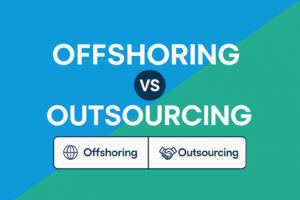Hiring the right app developer—or an entire development team—can make or break your app’s success. Misjudge the budget, and you could run out of funds mid-development. Underestimate complexities, and you’ll pay double or triple what you anticipated. Overpay and you’ll eat into profits and hamper future growth. In fact, research such as the CHAOS Report, show that only 29 percent of IT projects are delivered on time and on budget. The bottom line: understanding the true cost of hiring an app developer is the first step toward a successful launch.
This article provides a comprehensive analysis of the cost of hiring mobile app developers in 2025. It focuses primarily on the US market but offers options for working with in-house programmers remotely. It explores the differences between hiring a freelance developer, an agency, and an in-house employee, examines average salaries, and analyzes what determines the price. Let’s get started.
2025 Rates for Hiring App Developers in the US
The demand for developers continues to drive up hiring costs, though several factors, such as AI code generators like GitHub Copilot, are helping developers work more efficiently. That said, developers with specialized skills—such as AI, augmented/virtual reality, cybersecurity, and blockchain—command higher rates.
Here’s an overview of the cost of hiring developers in the US according to Talent and Salary.com.
Note: Prices can vary based on location (e.g., Silicon Valley vs. Kansas City), project complexity, and developer specialization.
1. Freelance App Developers
In general, freelance developers tend to have the lowest hourly rates (but a wide range.
The Pros of Hiring Freelance Developers:
- Lower cost for smaller projects: Freelancers are often a more cost-effective choice for small projects, especially when building a prototype or MVP.
- Flexible contracts: Freelancers can be hired on a temporary or hourly basis to work on specific parts of your project.
- Access to a wide range of talent: Freelance marketplaces like Upwork, Toptal, and Fiverr make it easy to find developers with different specialties and price ranges.
The Cons of Hiring Freelance Developers:
- Reliability and management: You must ensure deadlines are met, and you are responsible for quality assurance. Freelancers often juggle multiple projects.
- Limited capacity for complex projects: Freelancers typically work solo, so for larger, more complex projects, you’ll need a team.
- Risk of losing the developer: Freelancers can disappear, leaving you with the task of finding a replacement.
The Cost of Hiring Freelance Developers
Hiring freelance developers offers flexibility and often lower cost. Freelance app developers in the US typically charge anywhere from $20 up to $150 per hour depending on experience and expertise
Junior freelancers (newer developers) may charge on the lower end (around $25–$50/hour), mid-level around $50–$100/hour, and seniors upwards of $100/hour. For example, Indeed data shows a junior app developer in the US may charge around $27/hour, while a senior developer can charge over $64/hour.
Global marketplaces like Upwork skew lower, with a median of around $27/hour due to overseas talent , but US-based freelancers generally charge more.
Bottom line: If you’re working on a smaller project and cost is your primary concern, hiring a freelancer is your best option.
2. Development Agencies
The Pros of Hiring an Agency:
- Comprehensive services: Agencies provide everything you need, including programmers, designers, project managers, automation QA engineers, and maintenance staff.
- Better processes: Agencies offer structured timelines, clear milestones, and proper payment processes.
- Scalability: Agencies can scale up their resources if you need more help.
The Cons of Hiring an Agency:
- Higher cost: This is the most expensive option, with hourly rates ranging from $75–$200/hour, and even more for specialized developers.
- Less control: You typically interact with a project manager, not the developers directly.
- Expensive scope creep: Changes to the project scope can lead to extra costs.
The Cost of Hiring an Agency:
Agencies (app development firms) provide a full team (developers, designers, project managers, automation QA engineers) and charge higher rates to cover their overhead and comprehensive services.
According to spaceo.ca, “Top U.S.-based app development companies have a tendency to charge around $100 to $200 per hour for their app development process”.
In this list of top US app development agencies, Clutch notes that “The majority of mobile app development companies in the U.S. charge from $100 to $149 per hour.” Some smaller or localized agencies charge slightly less ($75–$100), while top-tier firms can charge even more, with some senior staff charging over $150 per hour. Typically, the fee also includes project management and other staffers, not just the line programmers.
Bottom line: Use an agency if you want the company to do everything for you and you trust the company to do a good job.
4. In-House Employees
The in-house option (using your employees) is the best solution if your company plans to continue developing its product. Since these programmers are your employees, it’s difficult to estimate the “cost per project” because they can work on multiple projects simultaneously.
The advantage of hiring in-house employees is that you don’t have to constantly search for additional staff when you need fixes or adjustments. After the project is completed, you can retain these employees as long as needed without having to hire extra workers.
The Cons of Hiring In-House Developers:
However, the downside is that if you hire full-time employees for a single project, you may end up wasting money if there’s not enough work to keep them busy. Alternatively, if you need to let them go, firing employees can be a lengthy process in some countries.
The Cost of Hiring In-House Developers:
Hiring an app developer in-house means bringing them on as an employee with an annual salary (plus benefits, taxes, etc.). In-house developers in the US have a wide salary range based on experience and location. On average, a mobile app developer earns about $110k per year.
While in-house devs aren’t paid by the hour, their salary roughly translates to $40–$80 per hour in cost. For example, a $100k/year salary equates to about $48/hour (assuming ~2080 work hours/year). In other words, you pay for the full-time employee, no matter what size project you’re working on.
If we estimate a six-month project, one programmer earning approximately $100,000 a year will cost around $50,000 (plus direct and indirect costs). Of course, for more complex projects, you may need additional employees or more time, which can increase your expenses.
Bottom line: In-house hiring works best for long-term projects or when you have multiple ongoing projects. What is the best solution cost-wise? Hire an in house app developer remotely, and you will be getting a dedicated employee at half of the cost in the US.
Key Factors Influencing App Development Cost
Several trends and factors in 2025 are impacting app developer costs:
1. AI and Automation
AI-assisted development tools (such as code generation, ChatGPT, Copilot, etc.) are beginning to boost programmer productivity. A recent survey by Stackoverflow. found that, as of 2024, 76% of developers are already using or plan to use AI coding tools. These tools can automate parts of the development process, potentially reducing the hours required for some projects.
However, AI coding assistants have not replaced developers—45% of developers say that today’s tools struggle with complex tasks. Overall, development could become a bit faster, reducing both development time and costs. Despite this, developers who can use and understand AI are still in high demand. In fact, developers with AI/machine learning skills often cost more, as integrating next-gen AI capabilities into apps requires significant expertise.
2. Location and remote work
Working with developers in different regions can reduce costs. For instance, a senior developer in San Francisco may charge $150/hour, while one in a less expensive city might charge $80/hour.
Hiring internationally (offshoring or nearshoring) is a common cost-saving strategy; regions like Latin America or Eastern Europe could save you 30–50%. In 2025, many US firms are taking a hybrid approach: keeping lead developers in-house and supplementing them with offshore developers for cost efficiency.
Hidden costs: Consider onboarding, training, collaboration tools (e.g., Slack, Jira), maintenance costs, and the cost of rework if requirements change during development.
3. Skill Set and Project Complexity
The specific technologies and complexity required for your app will influence cost. Niche skills (e.g. expertise in a particular enterprise system, or proficiency in a rare programming language) can mean bigger rates. Developing an enterprise-grade application that must integrate with legacy systems or handle millions of users will require more experienced (thus costly) developers than developing a simple consumer mobile app.
Likewise, a project involving cutting-edge tech (like blockchain, advanced AI, or IoT integration) might see higher quotes due to the specialized knowledge required. In contrast, simpler projects or those that can use common frameworks might be done by mid-level devs at a lower cost. Businesses are also increasingly exploring low-code/no-code platforms for simple apps – Gartner projects that by 2025, 70% of new applications will use low-code or no-code tools (up from only 25% in 2020)
While these tools can lower costs due to decreased demand for developers in some cases, that’s mostly the case for simple apps. In more complicated apps, you still need a good old programmer 🙂
4. Market Demand and Talent Supply
The demand for solid software and applications remains high in 2025 with further digital transformation. Certain skill sets are in greater demand, such as cloud services, cybersecurity, artificial intelligence integration, and AR/VR. When a developer has experience in these areas, it increases his or her market price. That said, there are more people entering the market, attending computer science programs and coding boot camps, which has increased the supply of developers. This has helped offset the rapid increase in salaries experienced several years ago.
For example, recent surveys show that in the US, median salaries have stabilized at about $110,000. These new developers, however, are mostly junior developers. The demand for experienced developers is still much higher than the supply, so you must pay much more for senior developers.
Cost-Effective Strategies to Hire Mobile Developers
Before you hire a developer to take your app to the next level, match the hiring option to your scope of work.
Let’s take a look at key factors and steps to take:
1. Identify Project Scope
When looking for app developers for Android, the first step is identifying your project’s scope and requirements for your new candidate. This means having a clear outlook of how you want your app to look, its features, functionality, and design.
Don’t be in a race to hire a cost-effective developer only to end up with a poor-quality app. Instead of taking risks with such low-budget developers, define what you want with your app and find someone with the potential to develop a quality-rich app at cost-effective prices.
2. Use In-House for Core, Ongoing Development:
If your business revolves around a software product or you foresee continuous development and updates, investing in an in-house developer or team is worthwhile.
In-house developers are a better option when you have multiple projects or your product requires many iterations. You can keep costs under control by hiring a small group of key employees who will stay with the company long-term, while the rest can be hired as contractors.
3. Think about the total ownership cost
Freelancers may charge a lower hourly rate, but if their work is subpar, the cost to fix it could be significantly higher (in some cases, you might even need to discard the code and start over). In-house programmers cost more upfront, but if they stay with your company long-term, you can get more value from them. It’s important to factor in the entire lifecycle cost of your app.
For apps critical to the business, it might be better to work with an agency or top-tier in-house developers. The more critical the app, the more you should invest in its initial development, ongoing maintenance, and the quality of the work.
4. Think Globally, Hire Globally
Why limit your search to local talent when you can widen your net and have the best? Embrace the magic of remote work by considering app developers from all corners of the world. If you’re open to a remote team, this can be a budget-friendly route while still getting overlapping work hours and solid talent. The caveat is to ensure the developers are well-vetted and that you manage any communication or time zone challenges.
Working with a specialized IT recruiting agency like DistantJob ensures you get the best IT talent around the globe. The companies understand your needs and provide pre-vetted candidates, making the process seamless.
Conclusion
Creating an app isn’t just a project – it’s an investment. The secret lies in hiring the best Android developers with the right skills and experience. Did you know that 78% of users would ditch an app if it stumbles on performance? Your developers are the backbone of a seamless user experience.
For cost-conscious business owners in 2025, a smart strategy is to start small and scale. Begin with freelancers or a small agency to develop the initial version of your app without major expenses. As your project grows and needs more attention, consider bringing talent in-house or working with larger agencies for more complex features. Always evaluate the hourly/salary costs in relation to the value delivered, such as experience, reliability, and speed. By understanding current market rates and carefully assessing your project’s needs, you can select the best hiring option to successfully deliver your app within a reasonable budget.
If you need help finding a remote app developer within your budget, we’re here for you. Just book a call with us to find out more about how we can help. We’ve been navigating remote waters for more than a decade and have matched US companies with affordable tech talent.





